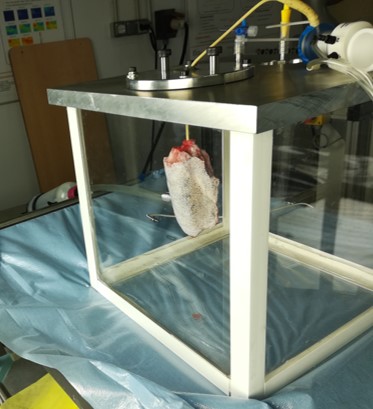Thematic Axis : Lung diseases

External vacuum inflation test on a lung segment, analysis of surface deformations by image stereo-correlation

The effects of air pollution on health have been recognised since the tragic London smog episode of December 1952, when more than 4,000 deaths were associated with the excessive increase, over five days, of two major atmospheric pollutants: the gas SO2 and fine and ultrafine particles.
In recent years, there has been growing interest in the incidence of respiratory diseases caused by exposure to air pollution. A key element in the development of these pathologies is the interaction of particles with the lipid film of pulmonary surfactant, which protects lung tissue and also controls respiratory mechanics and therefore lung capacity.
In this context, our initial work developed an ex vivo model of the alveolar wall reproducing the composition and microstructure of the surfactant as well as the mechanical stresses during respiratory cycles. The use of this model and the associated measurements made it possible to develop an approach for identifying the physico-chemical parameters of the particles that dictate their interactions with the pulmonary surfactant film.
Consequently, the first objective of this area is to classify airborne particles according to their interaction with the pulmonary surfactant and then according to the biological reaction (no interaction - particle expelled by the pulmonary defence mechanisms, pro-inflammatory interaction - particles inducing lipid oxidative stress or degenerative interaction - low oxidative particles that remain trapped in the surfactant inducing pulmonary fibrosis) that this causes in the lung.
The second objective is to master the physico-chemical/mechanical and biological interactions in order to build numerical models capable of predicting the impact of nanoparticles on pulmonary biomechanics. This second objective is based on the development of an experimental device for inflating a lung sub-segment to study its mechanical response with and without surfactant, in relation to its architecture as imaged by CT scan and the specific quality of the surfactant as characterised by a micropipette.
In recent years, there has been growing interest in the incidence of respiratory diseases caused by exposure to air pollution. A key element in the development of these pathologies is the interaction of particles with the lipid film of pulmonary surfactant, which protects lung tissue and also controls respiratory mechanics and therefore lung capacity.
In this context, our initial work developed an ex vivo model of the alveolar wall reproducing the composition and microstructure of the surfactant as well as the mechanical stresses during respiratory cycles. The use of this model and the associated measurements made it possible to develop an approach for identifying the physico-chemical parameters of the particles that dictate their interactions with the pulmonary surfactant film.
Consequently, the first objective of this area is to classify airborne particles according to their interaction with the pulmonary surfactant and then according to the biological reaction (no interaction - particle expelled by the pulmonary defence mechanisms, pro-inflammatory interaction - particles inducing lipid oxidative stress or degenerative interaction - low oxidative particles that remain trapped in the surfactant inducing pulmonary fibrosis) that this causes in the lung.
The second objective is to master the physico-chemical/mechanical and biological interactions in order to build numerical models capable of predicting the impact of nanoparticles on pulmonary biomechanics. This second objective is based on the development of an experimental device for inflating a lung sub-segment to study its mechanical response with and without surfactant, in relation to its architecture as imaged by CT scan and the specific quality of the surfactant as characterised by a micropipette.
